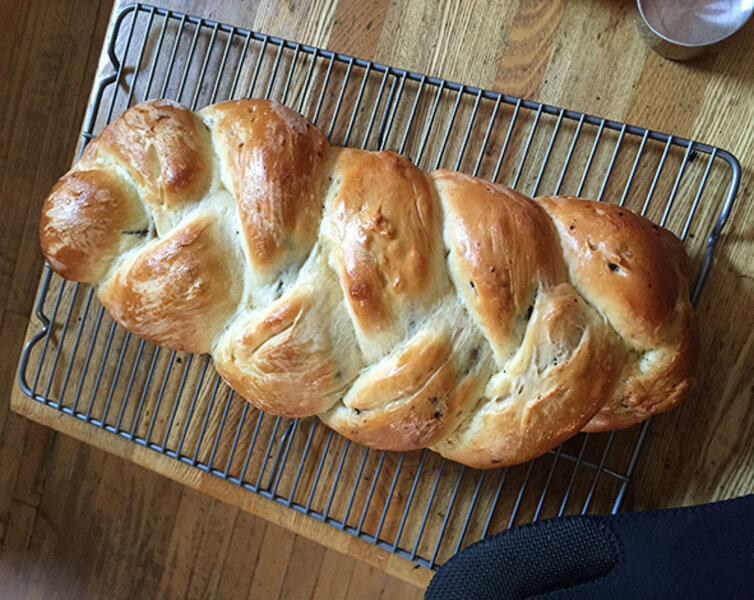Braided bread with a sweet twist: chocolate-filled challah
Loading...
My mother, a brilliant baker, used to routinely make elaborate, gorgeous, braided challahs with five, seven and even nine strands, filling them with chocolate, or candied fruits, or finely chopped nuts, or just cinnamon and sugar added with a cheerful generous hand. The scent, the anticipation, the burnished golden crust, all the ways we could use it: challah was a regular and wonderful part of my childhood.
I am fine with the classic three-strand braid. This recipe, which is essentially hers, may look fussy and involved. It’s not. It’s time consuming, as is any yeast bread – in the sense of having to wait while the rise happens – but it is very simple. And once you master it, you’ll rely on it again and again.
It looks beautiful, it tastes great, it is a crowd pleaser and it is something nice you can do for yourself. And if you want something simpler, as my mother sometimes did, omit the fancy chocolate filling and use water, not milk. Plain, regular challah on its own is great for sandwiches or as a bit of buttered toast in the morning on the way out the door. Learn this recipe and you will use it—and variations on it – forever.
Chocolate-filled Challah
Makes two big, beautiful loaves
1-1/2 packages yeast
1/3 cup warm water
1 teaspoon plus 1/2 cup white sugar
8 to 8-1/2 cups unbleached white flour
1/2 cup olive oil (use the mild stuff, not the big-bodied, precious kind)
2 teaspoons vanilla
2 cups milk
1 tablespoons salt
3 large eggs
2 more large eggs, divided into yolk and white
12 ounces semi-sweet chocolate, finely chopped
1/2 cup packed dark brown sugar
melted butter
Special equipment: Two baking sheets, lined with parchment paper or Cookina sheets
Proof the yeast. Dissolve the teaspoon of sugar in the warm water, then sprinkle the yeast on top. After a couple of minutes, stir it in.
Put the flour in a big bowl along with the salt. Gently heat the milk in a saucepan until it is warm – about 95 – 100 degrees F. but no warmer. Add the vanilla, the remaining 1/2 cup of white sugar and the olive oil and whisk together. Then whisk in the 3 eggs and the 2 egg yolks.
Add all liquids to the flour and mix. The dough will become shaggy. Flour a surface and turn the dough out onto it. Knead it about 5 to 8 minutes, until it is supple and lively and smooth.
Clean the large bowl, then dry and oil it. Put the dough into the bowl, turning it so it is coated all over with the oil. Cover it loosely—I used a piece of waxed paper.
For the first rising, you can put the bowl in a warmish place until it is doubled in bulk. You can also put it in the refrigerator overnight. It will rise more slowly, and the slow rise will give it a more delicious, subtle flavor.
Next, mix together the brown sugar and chopped chocolate in a small bowl. Divide it into 6 portions.
Pour the dough onto a lightly floured surface. Cut it in half and put one of the halves back into the bowl for now. Cut the half you are working with into three equal hunks (I used a scale to ensure they were about the same weight). One at a time, roll each hunk into a long skinny log and then, using a rolling pin, flatten the dough into a long rectangle, about 12 to 14 inches by 6 inches.
Brush the surface of each rectangle with melted butter. Sprinkle one portion of the chocolate and brown sugar mixture on top of each. Press the chocolate firmly into the dough using the flat of your hand. Then gently fold and roll up each rectangle into a log. Seal the edges.
Lay all three logs next to each other, seam sides down, on a lined baking sheet. Pinch the tops of all three together, then braid them. Tuck the ends under and pinch them together too.
Repeat this process with the other half of the dough to make the second loaf. Cover braided loaves lightly with waxed paper and let them rise in a warm place, like on top of the stove. When they are doubled in size (about 2 hours), brush them with beaten egg white.
Preheat oven to 350 degrees F. Place loaves on upper and lower racks and bake until golden (about 35 – 40 minutes), rotating loaves and swapping racks halfway through. They will be ready when they look gloriously golden and, when you thump the bottom, they sound hollow.
Transfer to cooling racks and let cool completely. Serve. Once the loaves are cooled, they can also be wrapped tightly and frozen.
Kitchen notes
Filling. You can also add cinnamon, a little cayenne, nutmeg, finely minced candied orange peel and candied cherries, or raisins that have been macerated in rum or hot water.
No filling. For an everyday loaf, omit filling entirely. If you like, after you brush the loaves with egg whites, sprinkle lavishly with poppy seeds.
Kosher. If you keep a kosher table, use water instead of milk and olive oil instead of butter.
Leftovers? Really? Should it happen that the bread hangs around your house more than a couple of days, you can slice it and use it for French toast.







